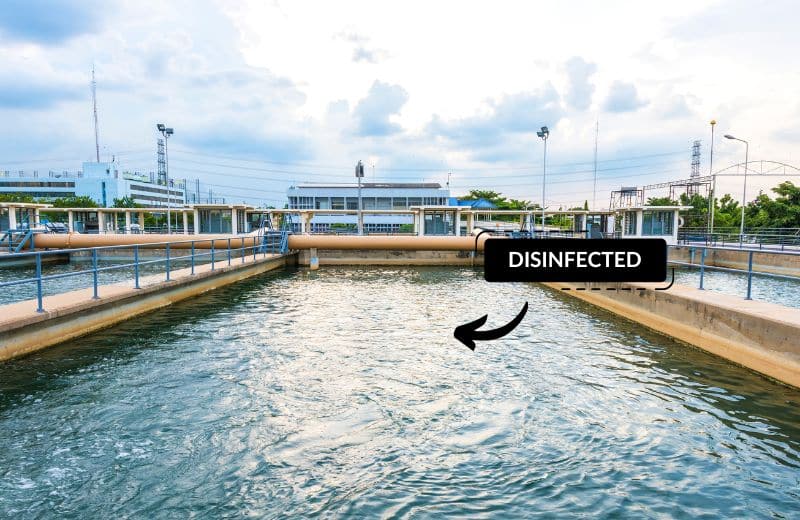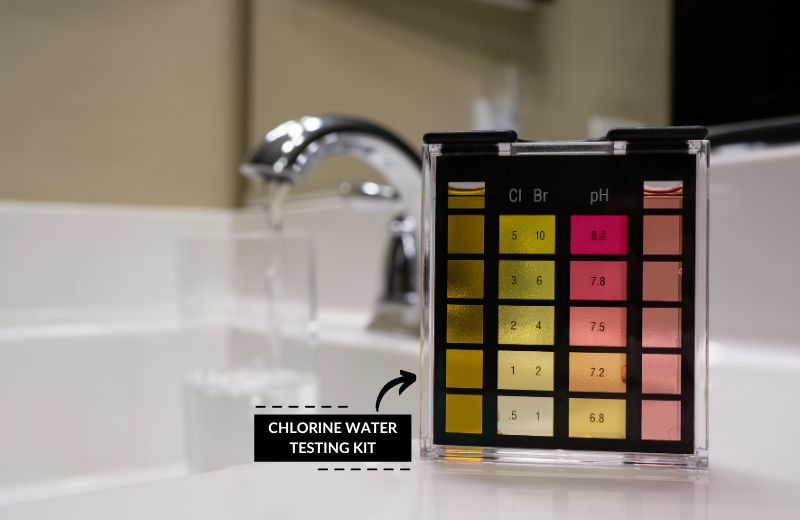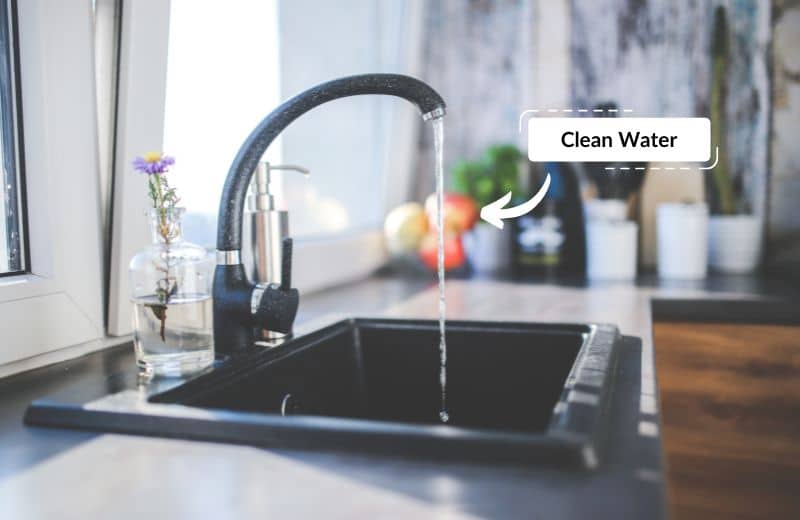Wondering how chloramine- and chlorine-treated water is different?
In this guide, we’ve shared the key differences between chlorine and chloramine for water disinfection, and concluded with our favorite choice based on the pros and cons of both.
📌 Key Features:
- Both chlorine and chloramine are popular disinfection chemicals used in drinking water treatment.
- Chlorine is simply chlorine in its purest form, while chloramine is a combination of chlorine and ammonia.
- Chloramine is better than chloramine in most cases because it lasts longer in drinking water and is less reactive with organic compounds.
Table of Contents
🤔 What Is Chlorine Disinfection?
Chlorine disinfection is the process of treating tap water with chlorine or chlorine compounds, which kills bacteria and other pathogens.
Water chlorination has a history dating back to the late 1800s, and states have been chlorinating their tap water supplies since 1908.
Chlorine is a halogen and a highly efficient disinfectant. When it’s added to water, it kills microorganisms by disintegrating their cell walls, preventing them from being able to reproduce and multiply.
According to the Environmental Protection Agency (EPA), up to 4 milligrams per liter (mg/L) or 4 parts per million (PPM) of chlorine gas can be used to safely disinfect drinking water.
🧐 What Is Chloramine Disinfection?
Chloramine treatment, or chloramination, is the process of adding chloramine to tap water for the same disinfection purposes.
Chloramine (formerly known as nitrogen trichloride)is made from chlorine and ammonia and has the chemical formula NH 2 Cl. The compound is made from an ammonia molecule (with up to three hydrogen atoms) that’s substituted with chlorine atoms.
There are two classes of chloramine compounds: inorganic chloramines and organic chloramines. Chloramine has been used by water utilities for disinfection purposes since the 1930s.
Chloramine disinfection works just like chlorine disinfection. As with chlorine, up to 4 milligrams per liter (mg/L) or 4 parts per million (PPM) of chloramine is considered safe in drinking water.

🆚 What’s The Difference Between Chlorine And Chloramine Disinfection?
The differences between the chlorine and chlorine disinfection processes are minimal – it’s the end result that differs slightly between the two.
For both chloramine and chlorine disinfection, the chemical is added as a final stage of water treatment, after coagulation, flocculation, sedimentation, and filtration.
Measured amounts of chlorine or chloramine are added to reflect the volume of water being treated, the initial water quality, and the distance that water needs to travel in the distribution system.
The main difference between chloramine and chlorine treated water is this: chlorinated water is more reactive with organic compounds, which increases the production of chemical byproducts, and chlorine doesn’t last as long as chloramine in water.
For these reasons, chloramine is best for tap water treatment. However, there are some exceptions, which we’ve discussed below.
⚖️ Pros & Cons of Chlorine & Chloramine Disinfection
Below, we’ve shared the advantages and setbacks of using chlorine vs chloramine in municipal water treatment plants:
Pros Of Chlorine Disinfection
Affordable & Widely Available
Chlorine remains the primary disinfectant in most US states because of its low cost and wide availability. Chlorine disinfection is, for most municipalities, the easiest and most affordable method of chemical disinfection.
Efficient Disinfectant
Chlorine is one of the most efficient and effective disinfectants available today. It’s completely reliable – as long as the optimal chlorine levels are achieved, the chemical can eliminate the potential for waterborne disease.
Safeer To Use In PWS With Lead Pipes
Chlorine reacts with lead to form an oxide. In lead pipes, this produces a protective layer that protects the pipes from corrosion, reducing lead leaching into water. Thousands of underground water pipes still contain lead, and we need to reduce our exposure to this toxic metal as much as possible.

Cons Of Chlorine Disinfection
Doesn’t Last As Long In Water
Chlorine doesn’t last as long in water as chloramine. That means that chlorinated water is only protected against bacterial growth and other microorganisms for a limited time before the effects of the treatment process wear off.
Produces More Disinfection Byproducts
The use of chlorine in water results in the production of disinfection by-products, such as TTHMs, and haloacetic acids, which have numerous concerning health effects, including cancer. Chemical compounds, like trichloramine and dichloramine, may also be produced if chlorine is added inadequately or pH levels are imbalanced.
Pros Of Chloramine Disinfection
Lasts Longer In Water
Chloramine-treated water offers better protection against microorganisms and provides longer-lasting disease control because chloramine lasts longer in water. That means water treated with chloramine chemicals should be safe and pathogen-free throughout its entire journey to your faucet.
Less Reactive With Organic Matter
Unlike chlorine, chloramine isn’t very reactive with organic compounds in untreated water. That means fewer disinfection byproducts are produced and water quality remains largely unaffected. As a result, the treated water is safer and healthier to drink.
Cons Of Chloramine Disinfection
More Difficult To Remove With Water Filters
Chloramine is more persistent in drinking water than chlorine. While chlorine gas dissipates out of water after a time, chloramine is trickier to remove. So, if you want to remove chloramine from your tap water at home, you’ll need a specialist filter for the job. A basic carbon filter is great at removing chlorine, but will struggle to remove chloramine.

Controversy Around Lead Pipes Leaching
Chloramine has made the news in recent years due to its link to increased leaching from lead pipes. When D.C. Water and Sewer Authority (WASA) switched from chlorine to chloramine for water disinfection in 2001, its water supply’s lead levels increased rapidly, reaching a concentration that was 83 times higher than the EPA’s accepted safe limit.
Arguably, if lead pipes didn’t exist in our public water systems, then we wouldn’t be at risk of lead exposure regardless of the type of disinfection chemical used.
🔎 Which Is Best: Chlorine or Chloramine Disinfection?
The chloramine and chlorine water disinfection processes are largely the same. When you drink water that has been disinfected by either of these chemicals – or any other chemicals, for that matter – you may notice a mild chemical taste and odor. Your water should be safe to drink, as long as the chlorine or chloramine levels are correct.
Chloramine is ultimately the best drinking water disinfectant. Chloramine is less reactive with organic matter, so it produces fewer chemical byproducts than chlorine. Plus, chloramine is more persistent in water and offers longer-lasting protection against bacteria and other microorganisms.
The only occasion when chloramine may be a less suitable choice than chlorine is in municipalities with lots of lead water distribution pipes. Chloramine doesn’t offer the protection against lead leaching that chlorine does, which may result in the accumulation of high levels of lead in your drinking water.
Want to find out whether your water company uses chlorine or chloramine for disinfection? Search online for your latest Water Quality Report or request a Report from your local water utility.
Related Posts:
- Everything You Need to Know About Chloramine in Water
- Best Ways to Remove Chlorine from Water at Home
❔ Chloramine Vs Chlorine Disinfection: FAQ
What is the difference in chlorine and chloramine?
The main difference between chlorine and chloramine is that chlorine is just chlorine, while chloramine is made from chlorine and ammonia combined. In terms of their effects in water, the difference between chlorine and chloramine is that chloramine lasts longer and produces fewer disinfection byproducts than chlorine, making it the preferable disinfection chemical.
Does tap water have chlorine or chloramine?
Your tap water might have chlorine or chloramine depending on the chemical used by your local water treatment plant. Chlorine was the original popular choice for drinking water disinfection, but chloramine is now rapidly gaining popularity due to its benefits compared to chlorine.
Is chloramine worse than chlorine?
No, for disinfection purposes, chloramine isn’t worse than chlorine – it’s actually better. Using chloramine instead of chlorine has better results because chloramine remains in the water for longer, offering longer-lasting protection against microorganisms. Plus, chloramine produces fewer disinfection byproducts. The only way that chloramine is worse than chlorine is that it’s more difficult to remove with an at-home water filter – a standard carbon filtration system might only be capable of removing chlorine.
Can you mix chlorine and chloramine?
No, chloramine and chlorine shouldn’t be mixed at a water treatment plant. Doing so could cause significant taste and odor issues.
Is chloramine stronger than chlorine?
No, chlorine isn’t stronger than chlorine. It’s not the case that you can a smaller volume of chloramine than chlorine to achieve the same disinfection results. However, chloramine does last longer in water, which gives the impression that it’s stronger in some sense.
